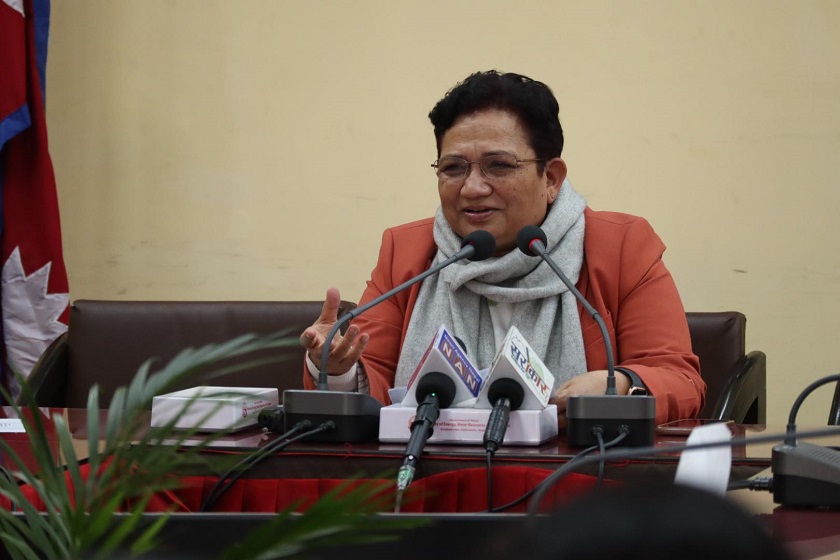Kathmandu, Aug 25 :
Minister for Energy, Water Resources and Irrigation Pampha Bhusal has underscored the need of collective efforts to create more avenues for unlocking climate finance for green grid investments.
She said this while addressing by virtual means the session ‘Unlocking climate finance for green grid investments’ under the forum, “Towards COP 27: Regional Forums on Climate Initiatives to Finance Climate Action and SDGs”, held in Bangkok, the capital of Thailand, today.
The forum is organized by the United Nations Economic Commission for Asia and the Pacific and the United Nations High-Level Climate Champions for COP26 and COP27.
Minister for Energy Bhusal said that the set of principles for unlocking climate finance for grids developed under the Green Grids Initiative “One Sun, One World, One Grid”, launched at COP26, needs wider dissemination and it is important to build capacity of countries like Nepal in the design and development of transmission and distribution infrastructures.
As the Minister shared on the occasion, in addition, the financing gap needs to be fulfilled to ensure that the transmission projects adhere to the principle of climate compatible grid investments. Hydropower in Nepal has the potential for nationwide electrification along with possibility of cross border electricity trade. Cross Border Energy Trade can have a massive impact in clean energy transition in South Asia, she said.
“Nepal is among the most vulnerable nations to climate change with the country’s delicate topography, climate-sensitive livelihoods of the people and their limited adaptive capacity. As a Least Developed Country (LDC) with an insignificant contribution to past and current global emissions, we recognize that, to meet the 1.5°C temperature goal, all countries need to undertake ambitious mitigation actions,” Minister Bhusal said.
Stating that as Nepal aim to move forward, it is crucial to recognize the pathway that will ensure a sustainable transition and Nepal’s Second Nationally Determined Contribution (NDC), 2020 has adopted ambitious targets for the next decade to mitigate emissions and increase resilience of vulnerable communities to adapt to the impacts of climate change.
According to her, among various targets, the Second NDC of Nepal aims to expand clean energy generation to 15,000 MW, of which 5-10 % will be generated from mini and micro-hydro power, solar, wind and bio-energy, by 2030. Similarly, by 2030, we aim to increase sales of electric vehicles to cover 90% of all private passenger vehicle sales and 60% of all four-wheeler public passenger vehicle sales.
“Residential cooking has been prioritized with target set at 25% of households using electric stoves by 2030. It is to be noted that the targets set by the second NDC of Nepal are mostly conditional and dependent upon mobilization of external resources,” the Energy Minister said, adding that the cost of achieving Nepal’s NDC conditional mitigation targets is estimated to be USD 25 billion while the cost of achieving unconditional targets outlined in the NDC is estimated to be USD 3.4 billion and that covers 5,000 MW of electricity generation only.
“Furthermore, with our Long Term Strategy for Net-zero Emissions, Nepal is committed to accelerating climate action with the goal to achieve net zero emissions by 2045. Nepal would also like to gain recognition for its mitigation contributions beyond its border through clean energy trade.
Clean energy adoption has really taken-off in Nepal. We have made significant progress in increasing access to electricity in the last decade. More than 95% of the households of the country have been electrified through grid and off-grid solutions and we aim to achieve universal electricity access by 2024.”
Stating that Nepal’s largest available renewable energy resource is hydropower with the current installed capacity around 2,300 MW, the Minister said with sufficient solar radiation and sunshine on an average of 300 days in a year, there is great potential for utilizing solar energy in Nepal.
She further said, “It is to be noted that, in Nepal, the Power System is a hydro-dominated where the demands are covered primarily by run-of-river (ROR) and peaking run-of-river (PROR) hydropower plants, with only around 100 MW of storage-based hydro. The lack of storage-based hydropower also is one of the challenges we face. Our Fifteenth Plan aims to diversify energy mix by developing reservoir, semi reservoir, pumped storage and other alternative energy projects. Given Nepal’s complex mountainous terrain and last-mile connectivity challenges, these approaches are needed to complement grid extensions.”
Informing the forum that Nepal will be in the state of net electricity surplus by 2025 from which Nepal will be a net exporter of power on Round-the-Year basis, Minister Bhusal said considering the current trend of annual electricity consumption growth rate, country cannot consume the surplus power.
“Accordingly, Nepal has identified a good prospect of producing and supplying green hydrogen by utilizing the surplus power. Hence, we are actively working towards introducing suitable interventions for promotion of green hydrogen,” she said.
(RSS)



